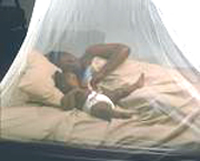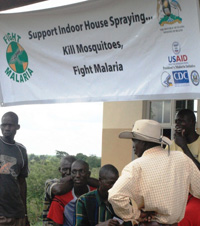Malaria War: Which Way for Uganda ?

 |
| Sleeping in a Net Protected Bed |
Statistical data obtained from Apac District Health Department shows there were 88,286 reported cases of malaria in Apac district between January and June 2008. That is approximately 467 people diagnosed with malaria everyday. But it is business as usual for Apac, where the malaria incidence rate is arguably the highest in the world.
The claim is backed by studies conducted in Apac by the National Malaria Control Programme of Uganda’s Ministry of Health, with funding from USAID, the American government’s international development agency. They determined the local Entomological Inoculation Rate (EIR), that is, “how many times somebody can get bitten at night by one specific species, the female anopheles mosquito, the one that transmits malaria parasites,” elaborates Dr. Matthew Emer, the Apac District Health Officer. “Anybody living in Apac is bitten by an infected mosquito, i.e. one able to transmit the malaria parasite, about six times in a night. That translates to about 1,560 times per person per year.”
In comparison,
Big threat
 |
| Anti-malaria Campaign in Uganda |
Records at
However, many malaria cases may be completely unreported. Dr. Alfred Acana, Director of Apac Hospital, observes that “patients come literally having diagnosed themselves, saying ‘I have malaria’. Ideally all of them should have a blood slide to check if their complaints are related to malaria,” but only “40-50% actually have blood slides done.”
He refers to the tendency of local people classifying any ailment as ‘malaria’. “Many go and treat themselves symptomatically with anti-malarials [but] it may not be malaria they’re treating. If they’re lucky it is malaria, then they get better.”
Struggling to cope
Even those who opt to get tested may not be able to do so.“The main reason,” Dr. Acana explains, “is the number who demand these services are more than the overwhelmed personnel supposed to test them. Also, the lab reagents [chemicals for tests] sometimes are not in supply, which makes it very difficult to confirm these complaints.”
On the whole, the district medical infrastructure is grossly under-resourced. For example, the Health Centre III in
What the government hospital is unable to provide, local private clinics can, at a fee. One such clinic in Apac town treats patients from all over Apac at its lab. Its technicians said that most cases were referred by
Fragile wings
“Malaria, being so high here, has so much affected development in this region,” observes Dr. Emer. “Mortality, for instance, in 11% of children [under-5s], is due to malaria. It rarely kills adults, many of whom are immune.” School-going children tend to be affected most, the doctor explains. As a result, affected children miss classes. This has severely retarded education and child development in the district. The very young may have had cerebral malaria which could have resulted in minor brain damage. This is evident by the fact that in this sub-region very few of our children are making it through to secondary school, or post secondary. The disease burden means that parents spend a disproportionate percentage of household income on medical care. Besides, impoverished parents cannot send their children to competitive schools, and rarely to university.
Chemical solutions
Is the situation desperate? “We don’t want to be pessimistic,” Dr. Emer says. “We have scaled up the case management strategy to the household level with the establishment of home-based management of fever using Homapak”. He refers to a chloroquine-fansidar combination therapy that was prepared specifically for children below the age of 5.
“Now we have some 68% of people who develop fever at household level and are given treatment within 24 hours,” he says. But malaria parasites were not slow to adapt. Drug-efficacy studies in the district show the parasites’ increased resistance to this therapy. “So the treatment policy was shifted to artemisin based combination therapy and that is what we are using now. Unfortunately we have not yet scaled this up to the household level. We are only able to provide it at facility level.”
Apac district currently uses its line-of-credit from the central government to access drugs from the National Medical Stores. Paying for them from the district health budget would be prohibitively expensive. Insufficient funding has also prevented wide-spread distribution of insecticide-treated mosquito nets, which are promoted by the Ministry of Health as an effective deterrent.
“We were not able to use nets as vector [parasite carrier] controls,” says Dr. Emer. “For that we need to have coverage of over 80% of households.”
Instead, the district targeted most vulnerable groups: children under five, and pregnant mothers. Limited indoor-residual spraying (IRS) using ICON, a synthetic pyrethroid insecticide, was also carried out in some schools, prisons and IDP camps during 2006-07.
While supporting this multi-sectoral approach, Dr. Acana also feels it is necessary to “strengthen the lower level units so that patients would get attention at primary level.”To tackle the insufficiencies of existing medical structures, he suggests “collaboration with private partnerships. There are so many private health practitioners who have the knowledge to treat and check for malaria.”
Ultimately, he believes correct diagnosis will remain central to fighting malaria. And gesturing towards
DDT conundrum
Even with these interventions, Dr. Emer explains, medical workers in Apac discovered they were only saving a few lives, leaving the malarial burden on the people intact. So when the idea of DDT came, “we thought that was the best we could do. In fact it is the most cost-effective vector control strategy which exists in the world”.
But it’s also the most controversial. DDT is recognised as one of 12 persistent, toxic chemicals by the Stockholm Convention on Persistent Organic Pollutants (to which
USAID, under the banner of the
“As for now, the funding is from development partners. It is a huge amount of money because it’s the first time we’re using such an intervention here,” Dr. Emer explains.
District health officials intend to promote mosquito net usage and medical interventions alongside yearly spraying. Indeed several houses in Oyam and Apac districts have been sprayed with DDT until a High Court injunction in June 2008 halted the process.
The Uganda Network on Toxic Free Malaria Control (UNETMAC), an anti-DDT lobby, argues before the court that DDT will damage the long-term health and livelihood of Ugandans. It also argued that essential guidelines set by the National Environmental Management Authority (NEMA), were not followed during the spraying process, thus prompting the injunction.
Mosquitoes are a resilient species, and for now, they look set to keep Apac in the record books.
First published in The Weekly Observer
